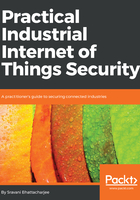
Building blocks of industrial IoT security architecture
For the three-tier architecture discussed in the previous section, the IIoT security architecture has to span end-to-end across the three tiers – from device endpoints at the edge, through the platform tier, and ultimately to the enterprise tier. In the case of layered databus deployments, the security framework needs to encompass the databus communication and schemas, the endpoints at each layer, and also the interlayer communication through the databus gateways. This proves the pervasive nature of IIoT security. Besides, security can't be bolted on as an afterthought, rather security risks should be evaluated early in the deployment lifecycle; and countermeasures must be built into the design. These security requirements are however, not always easy to implement in real-world industrial IoT deployments, due to some distinguishing characteristics of IIoT, as excerpted below from IIC's Industrial Internet Security Framework (IIC-IISF) document:
- Since IIoT involves both IT and OT, ideally security and real-time situational awareness should span IT and OT subsystems seamlessly without interfering with any operational business processes.
- Average lifespan of an industrial system is currently 19 years. Greenfield deployments using the most current and secure technologies are not always feasible. Security technology must often be wrapped around an existing set of legacy systems that are difficult to change. In both greenfield and brownfield deployments, all affected parties—manufacturers, systems integrators and equipment owner/operators—must be engaged to create a more secure and reliable IIoT system.
- As there is no single "best way" to implement security and achieve adequately secure behavior, technological building blocks should support a defense-in-depth strategy that maps logical defensive levels to security tools and techniques. Due to the highly segregated nature of industrial systems, security implementation needs to be applied in multiple contexts. Multiple sub-networks and differing functional zones may have different operating technologies and security requirements. Security tools and techniques built for IT environments may not always be well suited for OT environments.
- IIoT systems may have constrained system resources that need to meet various requirements, such as system safety and real-time execution. These factors may not allow implementing all security measures and controls to their fullest extent (as required by the defense-in-depth strategy). The security program implementation considerations should take into account all the required functional and non-functional aspects of the system behavior, including their relative priorities.
Based on the preceding distinguishing characteristics, Figure 2.11 shows the functional building blocks for a multilayered IIoT security framework from edge to cloud proposed by (IIC-IISF). It maps to the functional viewpoint of IIC's reference architecture:

The functional viewpoint of the security framework is composed of six interacting building blocks. These building blocks are organized into three layers. The top layer consists of the four core security functions: endpoint protection, communications and connectivity protection, security monitoring and analysis, and security configuration management.
These four functions are supported by a data protection layer and a system-wide security model and policy layer.
A brief description of each of these layers has been excerpted from (IIC-IISF):
- Endpoint protection: This implements defensive capabilities on devices at the edge and in the cloud. Primary concerns include physical security functions, cyber security techniques, and an authoritative identity. Endpoint protection alone is insufficient, as the endpoints must communicate with each other, and communications may be a source of vulnerability.
- Communications and connectivity protection: This uses the authoritative identity capability from endpoint protection to implement authentication and authorization of the traffic.
Cryptographic techniques for integrity and confidentiality, as well as information flow control techniques, protect communications and connectivity.
Once endpoints are protected and communications secured, the system state must be preserved throughout the operational lifecycle by security monitoring and analysis, and controlled security configuration management for all components of the system.
These first four building blocks are supported by a common data protection function that extends from data at rest in the endpoints to data in motion in the communications. It also encompasses all the data gathered as part of the monitoring and analysis function and all the system configuration and management data. - Security model and policy: The functional layer governs how security is implemented and the policies that ensure the confidentiality, integrity, and availability of the system throughout its lifecycle. It orchestrates how all the functional elements work together to deliver cohesive end-to-end security.